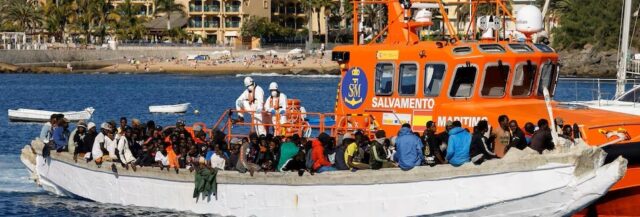
(3 Minutes read)
Spain has registered 21,926 migrants in the last five months, most of them were from sub-Saharan Africa and the Maghreb too.They are Senegalese, Malians, Guineans, Gambians, Moroccans, Ivorians, Togolese, Nigeriens… among other African nationalities who continue to brave the sea at the risk of their lives.
Senegal, which was the starting point for most of the canoes leaving sub-Saharan Africa in 2023, passed the baton to Mauritania where the majority of boats come from in 2024. Many small boats also come from Morocco. The Spanish Interior Ministry, which often gives entry figures, reveals those for the first five months of the year. However the flow has decreased in recent months (In Senegal, many boats were initially stopped by the new authorities).
It continues: Even if the pace slowed down between March, April, and May, the arrival of migrants in small boats or cayucos in the Canary Islands increased by 259.6% in the first five months of 2024, with 17,117 people registered, according to data published by the Spanish Interior Ministry on Monday June 3.
Across Spain, the increase in irregular migrant arrivals was 137% in the first five months of the year to 21,926, an increase due to a spike in the number of migrants arriving in the Canary Islands at the beginning of the year, but which has slowed down in recent months.
Between January and February, 11,932 migrants arrived irregularly. A drop in March: 1,183, in April around 2,800, and this last month of May, 1,135. Data from the Ministry of the Interior’s bimonthly report on irregular emigration reveals that over the past five months, irregular arrivals to the Canary Islands have increased by 259.6% compared to last year, reaching 17 117 people registered. In 2023, at the same time, 106 precarious boats had reached the Canarian coast after crossing what is considered one of the most dangerous routes in the world, and in 2024, 261 have already been recorded.
Despite the increase recorded during this period, arrivals to the Canary Islands decreased compared to the first months of the year: between January and February, 11,932 migrants arrived irregularly, in March there were 1,183, in April approximately 2,800 and this last month of May, 1,135.20,854 arrived by sea, 1,056 by land
Of the total number of irregular arrivals across Spain as a whole, the vast majority (20,854) arrived by sea, 12,042 more than in the first five months of 2023.On the other hand, the number of people who reached the peninsula and the Balearic Islands by sea continues to decrease (-6.6%): last year 3,987 migrants arrived and so far, in 2024, 3,723 arrived.
Read Also:
The number of people arriving by sea in Ceuta and Melilla has also decreased significantly: in the first case, 13 migrants arrived compared to 22 last year, and in the second autonomous city, 1 instead of 43 in 2023. By land, during these five months irregular arrivals increased in Ceuta, where 1,056 migrants arrived – 667 more than in 2023 – and those in Melilla decreased, the autonomous city having received 16 people, or 35 of less than during the same period last year.











